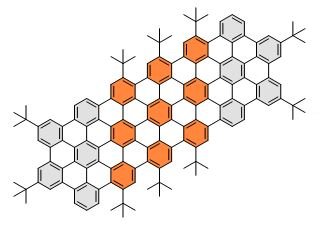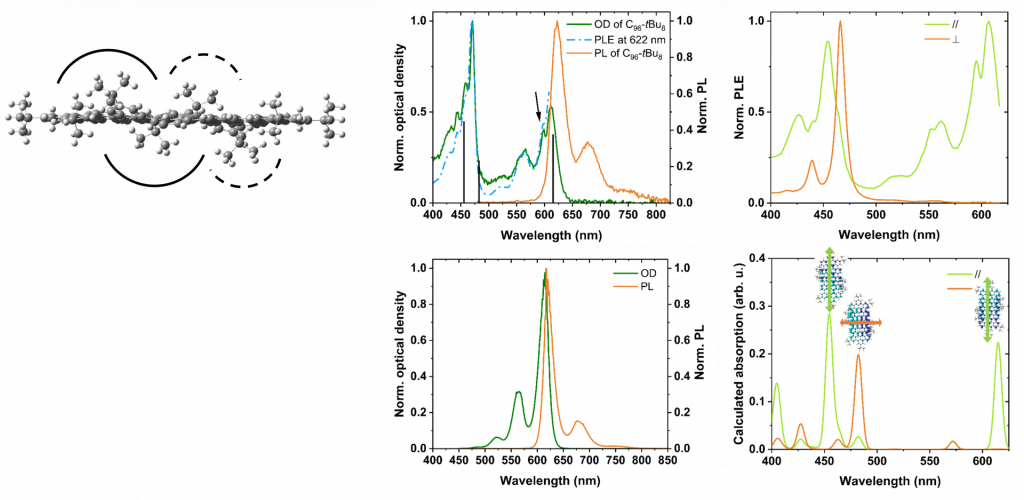Graphene, a two-dimensional material, possesses remarkable mechanical and electronic properties that can be used for a wide range of applications: reinforcement of composite materials, electrical energy storage devices, etc. The reduction in size of this 2D material, into well-calibrated nanometric-sized elements, gives it new and original properties that deserve to be studied more widely. However, we still need to know how to prepare these objects, either by controlled cutting of the size of the sheets, or by chemical synthesis.
It is by the latter route, well mastered by the IRAMIS/NIMBE UMR 3685, a CEA Paris-Saclay research Unit, in collaboration with ENS Paris-Saclay (LuMIn, FRE 2036), the University of Mons (Belgium) and the University of Warsaw (Poland), that a family of elongated graphene nanoparticles containing 78, 96, 114 and 132 sp2 carbon atoms has been synthesized and studied (see figure below). These particles stand out for their very good solubility due to very weak π-π interactions, enabling easy handling and a very precise description of their properties in line with theory.
Another interesting property is their emission in the red and near-infrared with photoluminescence quantum yields between 90 and 95%, which has never been achieved for this type of compound at these wavelengths. This work has been published in the journal Nature Communications.

Over the past decade, there has been renewed interest in synthesizing graphene nanoparticles using the “bottom-up” approach, i.e. organic chemistry methods. In particular, this approach enables control of particle morphology to the nearest atom, as well as the structure of edge states (zigzag vs. armchair) and the presence of functional groups. This has led to significant progress in the synthesis of graphene quantum dots (GQDs) and in their theoretical description.
However, the study of the optical properties of GQDs, particularly at the single-molecule scale, remains a challenge due to the low solubility of the products as their size increases. Recently, we demonstrated that triangular-shaped graphene nanoparticles containing 96 sp2 carbon atoms exhibit single-photon emission properties at room temperature as well as at low temperatures. To go further and fully exploit the potential of these objects for quantum technologies, it is essential to study in greater detail the relationship between their structures and properties.
In a new publication in the journal Nature Communications, the synthesis of a family of elongated GQDs containing 78, 96, 114 and 132 sp2-hybridized carbon atoms(C78-tBu6, C96-tBu8, C114-tBu10 and C132-tBu12) is presented: these particles show very good solubility with complete individualization of the molecules in solution and in the solid state in a polymer matrix (except, paradoxically for the smallest particle, C78-tBu6). This solubility is achieved thanks to the specific localization of tert-butyl groups (-C(CH3)3) in GQDs, which significantly enhance their individualization, without affecting the delocalization of π-conjugated systems.

These particularly large GQDs have fluorescence quantum yields of around 90% or more. We have studied the photophysics of GQDs and given a precise description of their properties by combining optical experiments and ab-initio calculations performed by TDDFT (Time-Dependent Density Functional Theory). Modeling and experiments were found to agree in predicting the variation of excited state energy and oscillator strength with nanoparticle size. The calculations also describe very well the measured polarization dependence of the first excited states (Figure 2). In the future, the accuracy of the comparison between theory and experiment will be pushed further with low-temperature studies, able to reveal the electron-vibration coupling and its evolution as a function of GQD structure.

Structure, photophysical studies (upper frames) and DFT and TDDFT calculations (lower frames) performed on a C96-tBu8 graphene particle.
NB: The presence of two (or more) adjacent tBugroups is necessary to prevent π-stacking between graphene nanoparticles and enable their individualization in solution and in the solid state.
Mastering the synthesis of these graphene nanoparticles with their well-understood properties, well-calibrated and chemically tunable size, easy dispersibility and individualization, paves the way for the use of GQDs as photon emitters for a variety of applications, notably in quantum technologies by integrating them, for example, into photonic arrays for quantum key distribution. As these particles are only one atomic layer thick, it is also possible to take advantage of their extreme sensitivity to the local environment for applications in the field of quantum sensors.
Reference :
“Interplay of structure and photophysics of individualized rod-shaped graphene quantum dots with up to 132 sp² carbon atoms”
D. Medina-Lopez, T. Liu, S. Osella, H. Levy-Falk, N. Rolland, C. Elias, G. Huber, P. Ticku, L. Rondin, B. Jousselme, D. Beljonne, J.-S. Lauret and S. Campidelli, Nat. Commun. 2023, 14:4728.
CEA contact: Stéphane Campidelli (NIMBE/LICSEN)
Collaboration :
- Université Paris-Saclay, CEA, CNRS, NIMBE, LICSEN and LSDRM, 91191, Gif-sur-Yvette, France
- Université Paris-Saclay, CNRS, ENS Paris-Saclay, CentraleSupélec, LuMIn, 91400, Orsay, France
- Chemical and Biological Systems Simulation Lab, Centre of New Technologies, University of Warsaw, Banacha 2C, 02-097, Warsaw, Poland
- Laboratory for Chemistry of Novel Materials, University of Mons, 7000, Mons, Belgium




